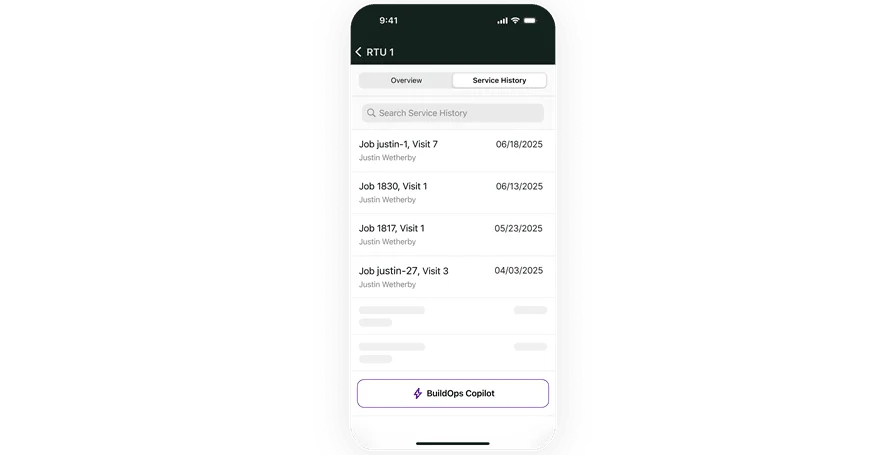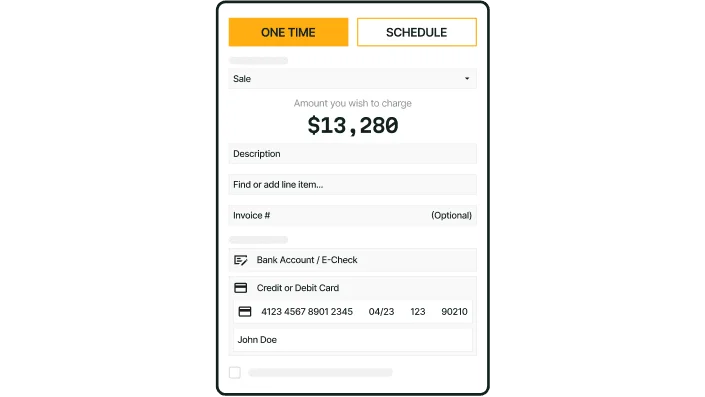Keeping service calls organized, techs informed, and schedules tight takes more than a clipboard and a gut feeling. In the HVAC industry, where every minute of downtime hits your bottom line, the best HVAC software keeps your entire operation moving. From the office to the field, it gives your team instant access to jobs, customer history, and real-time updates—right from their phones or tablets.
Gone are the days of chasing paper trails or calling back and forth just to get a job scheduled. Web-based HVAC software is an online system that manages everything from dispatching and job tracking to quoting, invoicing, and customer communication—all accessible from any device with internet access. Whether you're handling emergency repairs, routine maintenance, or coordinating multiple crews, it keeps your entire team connected and ready to act.
This guide breaks down:
- How to choose HVAC web-based software
- 6 key features to look for in web-based HVAC management software
- 6 top HVAC web-based software tools
- 7 real-world benefits of using web-based HVAC software
- 4 common HVAC software questions answered
Whether your shop handles installs, maintenance, or service agreements, picking the right HVAC web-based software changes how your team works. Let’s walk through what to look for—and how to make the smartest choice for your business.
How to choose HVAC web-based software
Choosing HVAC web-based software can change how your entire team operates—both in the field and at the office. The right platform keeps jobs moving, techs informed, and dispatchers in sync, all without relying on outdated paperwork or constant phone check-ins. But not all HVAC platforms function the same way. Contractors need software that supports their specific workflow—from scheduling and dispatching to invoicing and tracking maintenance agreements.
Before locking in a solution, here are the key things to look for:
- Scalability – Can it keep up as your service area grows or your team expands? Will it support multiple crews, regions, or job types without slowing down?
- Mobile access – Can your techs check work orders, log notes, and pull up customer history from their phone or tablet? Does it update in real time so dispatch and techs stay in sync?
- Integrations – Does it plug into your existing accounting, CRM, or inventory system? Can it eliminate double entry and help everything flow through one system?
- Ease of use – Can your team pick it up quickly without weeks of training? Will it help speed up daily work—or add friction and confusion?
- Support and updates – Does the provider offer responsive customer support? Are system updates rolled out regularly or do you risk using outdated tools?
- Access and reliability – Can your team log in from any device without performance issues? How does the software handle outages or connectivity drops?
- Core features – Does it handle HVAC-specific needs like dispatching, recurring maintenance tracking, job costing, and customer communication? Are reporting and job analytics built in or add-ons?
Having the right capabilities matters—but what separates web-based HVAC software from other setups? Let’s dig into that next.
What makes web-based HVAC software different from other HVAC software types?
Coordinating service calls, managing install crews, and staying on top of maintenance jobs all require software that doesn’t slow you down. HVAC web-based systems give your office and field teams the tools to stay connected without being chained to one location or buried in manual updates.
Let’s break down how it stacks up against other options:
- Web-based: Opens in a browser. Accessible from anywhere with an internet connection. No need to install updates or manage servers. Teams can dispatch jobs, view service history, and invoice—all on the go.
- Desktop or in-house: Runs on local servers or specific office computers. Limits field access, requires manual updates, and usually needs dedicated IT help to maintain.
- Hybrid: Some features run online, others stay tied to local machines. It works for certain setups but adds complexity when scaling or managing remote teams.
- Mobile-only apps: Designed for techs on the move but may lack key functionality like advanced scheduling, quoting, or customer data management. Handy for simple tasks, but harder to build a full workflow around.
If your team needs to stay responsive without delays or hardware headaches, web-based HVAC software keeps jobs flowing and your crew aligned from dispatch to closeout.
6 key features to look for in web-based HVAC management software
Running a busy HVAC operation means keeping schedules tight, techs equipped, and job details up to date—without slowing down the crew or overwhelming the back office. Web-based HVAC software simplifies this by automating the core tasks that eat up time: dispatching, quoting, invoicing, and real-time communication. Here are the six features that make it all work:
1. Smart scheduling and dispatch
HVAC jobs don’t always follow a script. A strong dispatch board powered by web-based HVAC software helps you assign jobs based on skill, availability, and location—without wasting time shuffling through paper or whiteboards. It updates in real-time, so when a tech wraps up early, dispatch can drop in the next service call instantly.
Think back to a summer when your team was slammed with AC breakdowns. A dispatcher sees one crew finishing early across town. Instead of calling around, they drag the next job into the calendar, and it syncs right to the tech’s phone. That’s how web-based dispatching software for HVAC cuts response time and boosts job count without extra hands.
2. Mobile access for technicians
Techs in the field need fast access to job details, service history, photos, and customer signatures—without calling the office every 10 minutes. A technician mobile app for web-based HVAC software puts everything in their pocket, cutting down on miscommunication and wasted trips.
Here’s a scenario: your tech arrives at a site and realizes the client didn’t mention a second unit. Instead of guessing or driving back for parts, they pull up the full history, take a photo, and tag the additional unit right in the app. The office sees it, updates the quote, and the job stays on track—all without a single phone call.
3. Seamless invoicing and payments
Speed matters when it comes to getting paid. HVAC web-based software lets your techs create, send, and sync invoices as soon as the job is done. With web-based invoicing for HVAC software, everything flows straight into your accounting system—and with integrated payment tools, customers can pay on-site or online, cutting delays.
Take for example a tech finishing up a rooftop unit replacement at a commercial property. Before leaving, they tap out the invoice, send it, and the property manager pays through the client portal. No more “I’ll get it to you later” or checks lost in the shuffle.
4. Service agreements and preventative maintenance
For contractors handling long-term maintenance contracts, automation is non-negotiable. Web-based HVAC software for service agreements keeps track of all recurring work, upcoming inspections, and equipment due for a check-up—so nothing slips through.
Let’s say you manage 200+ commercial PM contracts across multiple buildings. Your system sends reminders, auto-schedules the work, and gives techs the service checklist when they show up. Instead of scrambling to remember which rooftop units are due this quarter, the schedule runs itself—and your customers stay covered.
5. GPS fleet tracking and route optimization
Wasted drive time kills productivity. Fleet tracking for web-based HVAC software helps you see where every truck is, which tech is closest, and how to reroute when emergencies hit. You also get insights into fuel usage and downtime to help cut overhead.
Here’s one: during a weekend emergency, a hospital calls with a cooling issue. With GPS tracking, dispatch spots the closest available tech and sends them straight there—no backtracking, no guesswork. That tech’s ETA updates automatically, and the customer gets a heads-up within seconds.
6. Real-time reporting and analytics
You can’t fix what you can’t see. Reporting tools for HVAC web-based software pull together job data, tech performance, and revenue trends so you can make decisions with facts—not gut feel. These dashboards highlight what’s working and where things are slipping.
Think of a time you noticed more callbacks last month but didn’t know why. Reporting shows one junior tech is running longer than average on install jobs. Now you can drill in, retrain, and rebalance workloads—before it turns into lost business.

HVAC software built for commercial
BuildOps empowers HVAC contractors to streamline operations and increase profits.
Other notable features to have in a HVAC web-based software
Once the basics are covered, a few added tools can make a big difference in how smoothly your operations run:
- Quote building tools – Web-based quoting software for HVAC helps your team generate accurate proposals with pre-loaded pricing and templates—right from the field or office.
- Pipeline visibility – A pipeline management tool keeps your team focused on job status, upcoming bids, and customer follow-ups—all in one place.
- Time tracking and payroll sync – Time tracking tools for HVAC software let techs log hours from their phones and sync everything automatically with payroll.
- Centralized customer management – Web-based CRM software for HVAC organizes client info, service history, and contact records, making it easier to prep before a visit or follow up after.
- Custom reporting dashboards – Web-based reporting for HVAC teams lets you track job progress, tech performance, and service revenue in real-time to spot trends and improve faster.
With these features in place, your software does more than just manage jobs—it gives you visibility across the entire operation. Now that we’ve covered what to look for, let’s walk through the top HVAC web-based software options on the market and how they stack up.
6 top HVAC web-based software tools
Finding HVAC web-based software that fits your business takes more than just browsing features. Some platforms are tailored for high-volume residential work, while others specialize in complex commercial jobs. Below are six of the best options, each offering strengths that align with different business models—from small teams to full-scale commercial contractors.
1. Best for commercial contractors: BuildOps
BuildOps is designed specifically for commercial HVAC contractors, offering an end-to-end web-based platform that handles dispatching, quoting, scheduling, service agreements, invoicing, and reporting—all in real time. It brings together every part of your operation, giving dispatchers, techs, and the back office one shared system to work from. Crews in the field stay connected with access to job details, while the office tracks job progress, monitors technician performance, and manages multiple service locations from a single dashboard.
How Pricing Works: BuildOps offers personalized demos so contractors can explore features that match their operation and scale. Pricing is custom-fit based on team size and required functionality.
Why Web-Based Works Better: Commercial HVAC teams need tight coordination across job sites, mobile-friendly tools for field access, and real-time updates for dispatch and customer service. Web-based systems like BuildOps cut down delays and eliminate the need for constant check-ins or server maintenance.
What Sets It Apart for Commercial: Built around commercial HVAC workflows, BuildOps includes advanced features like client property hierarchies, drag-and-drop dispatching, AI-powered reporting, and preventive maintenance tracking—all tailored for high-volume, multi-location jobs.

Want to see it in action?
We help contractors simplify operations, cut costs, and boost revenue.
2. Best HVAC web-based software for residential contractors: Housecall Pro
Image Source: Housecall Pro
Housecall Pro is a popular option for residential HVAC contractors. It combines scheduling, invoicing, and customer management into a single mobile-friendly platform. Many small to mid-sized residential shops appreciate how quick it is to set up and how easy it is to use. Techs can update job statuses on the go, send invoices right after the job, and collect payments all from their phones. Built-in marketing tools also make it easier for contractors to stay top-of-mind with customers.
However, Housecall Pro isn’t ideal for larger operations. It lacks advanced reporting features, enterprise-level asset tracking, and robust service agreement management, which many commercial teams rely on.
How Pricing Works: Housecall Pro uses a tiered pricing model with options for solo techs up to growing teams. Plans increase based on features like custom notifications, online booking, and automation tools.
Why Web-Based Works Better: Residential HVAC contractors often deal with last-minute jobs, high call volumes, and urgent repairs. A web-based solution like Housecall Pro keeps techs, admins, and customers aligned in real time without paper or office trips.
3. Best HVAC web-based software for general contractors: Jobber
Image Source: Jobber
Jobber offers a clean, easy-to-use web-based platform built with general service contractors in mind—including those in the HVAC space. It helps with quoting, job tracking, scheduling, and invoicing, and comes with a helpful client hub where customers can approve estimates, pay online, or rebook service. Jobber is a solid pick for smaller teams or general contractors juggling different trades and services under one roof.
That said, Jobber may not be the best fit for commercial HVAC contractors who need complex job workflows, equipment tracking, or deep integration with advanced inventory systems.
How Pricing Works: Jobber pricing starts at a lower monthly rate with essential tools, then expands into plans that offer automation, batch invoicing, and advanced reporting.
Why Web-Based Works Better: General contractors benefit from having job details, schedules, and communications all in one place. A web-based tool like Jobber lets them manage multiple types of work across different clients—without chasing paperwork or status updates.
What Sets It Apart for General Contracting: Jobber stands out for its simplicity, mobile access, and flexible job tracking. It works well for HVAC companies that do a mix of residential and light commercial work without needing complex enterprise-level tools.
4. Best for mid-sized HVAC contractors: FieldEdge
Image Source: FieldEdge
FieldEdge HVAC software is built for contractors who’ve outgrown spreadsheets but don’t need enterprise-level complexity. It covers quoting, dispatch, maintenance agreements, invoicing, and technician tracking—all through a web-based system that works across desktop and mobile. FieldEdge is QuickBooks-integrated, which makes it especially helpful for shops that want real-time financial visibility without switching accounting platforms. That said, FieldEdge might fall short for larger HVAC operations needing advanced analytics, job costing, or multi-location client support.
How Pricing Works: FieldEdge pricing is customized based on user count and selected modules. It typically operates on a per-user monthly rate with onboarding services available.
Why Web-Based Works Better: Web-based access helps office staff and techs stay in sync without relying on paperwork or old-school dispatch boards. Everything updates in real time—from quotes to payments.
What Sets It Apart for Mid-Sized Shops: It’s a solid middle-ground tool for growing HVAC contractors looking for visibility, mobility, and streamlined admin—all without the learning curve of heavier platforms.
5. Best for field-focused HVAC teams: Service Fusion
Image Source: Service Fusion
Service Fusion HVAC software caters to mobile-first HVAC teams that prioritize real-time scheduling and quick job turnarounds. The platform includes customer management, dispatching, time tracking, and mobile payments—all in a clean, web-based interface. It’s popular with contractors who need their techs to work independently in the field without waiting on calls from the office. Still, Service Fusion may not be ideal for contractors needing deep integrations, custom reporting, or complex workflow management across large teams.
How Pricing Works: Service Fusion offers flat-rate pricing, which makes it appealing to HVAC businesses managing costs as they grow. It includes unlimited users per plan, making it a standout for expanding teams.
Why Web-Based Works Better: With crews constantly in motion, web-based access ensures techs have up-to-date job info, customer notes, and service histories no matter where they are.
What Sets It Apart for Field Teams: The platform is light, fast, and highly mobile—giving techs everything they need on the go without bogging them down with too many features they’ll never use.
6. Best startup-friendly HVAC software: Kickserv
Image Source: Kickserv
Kickserv HVAC software is a go-to choice for new HVAC shops that need something functional, web-based, and budget-friendly. It offers online booking, estimates, job scheduling, mobile invoicing, and payment collection—all in one interface that’s easy to learn.
How Pricing Works: Kickserv has a free tier for solo operations, with paid plans adding features like automation, custom forms, and CRM tools. It's cost-effective and scales gradually as your business grows.
Why Web-Based Works Better: For new HVAC contractors trying to stay organized while ramping up, a web-based system like Kickserv helps get jobs on the calendar and payments in the bank—without added admin time.
What Sets It Apart for Startups: Quick to deploy, simple to use, and packed with just enough features to help small teams look professional from day one.

Check out the HVAC growth report
See how leading HVAC contractors are able to maximize commercial growth.
7 real-world benefits of using web-based HVAC software
Web-based HVAC software doesn’t just organize your operation—it gives your team the speed, clarity, and control they need to stay ahead. Whether you’re managing one truck or running a multi-crew business, the advantages show up where it matters most: fewer delays, better service, and more jobs done right the first time. Here are seven real-world benefits HVAC contractors gain from using web-based tools:
1. Faster service from quote to invoice
When everything lives in one system—scheduling, quoting, job details, and invoicing—your team spends less time chasing paperwork. Web-based software lets you quote faster, schedule instantly, and send invoices on the spot, so no time gets lost between steps. Take a maintenance call for a rooftop unit. Your tech finishes the job, marks it complete, and the invoice hits the customer’s inbox before they even leave the site. Payments get collected faster, and cash flow stays healthy.
Deep Dive
Our guide on the Invoicing Sweet Spot breaks down how getting paid faster directly impacts technician productivity and business profitability, and includes specific time windows explaining how much longer it takes for you to get paid the later you send out your invoices.
2. Better visibility across teams
When your scheduler, dispatcher, and techs are working off the same system in real time, you cut down on back-and-forth calls, duplicate entries, and confusion. Everyone sees the same job status, customer notes, and service history—whether they’re in the office or out in the field.
Teams running large commercial accounts benefit most here. The best commercial HVAC field service software highlights how centralized systems create better communication and stronger accountability across departments.
3. Less time spent on manual entry
Double entry eats up hours. Whether it's logging time, entering invoices, or syncing job notes to the CRM, manual processes leave room for errors—and burn daylight. HVAC web-based software automates those handoffs between tools, so your techs spend less time on keyboards and more time on-site.
The top HVAC software shows how automation can streamline your business, save valuable hours, even for lean teams with limited admin resources.
4. Easier access to job history and equipment data
When your techs can pull up a customer’s service history, past issues, or unit details from their phone, they walk in prepared. That means faster diagnosis, fewer mistakes, and less backtracking to get the job done. Let’s say a return visit is scheduled for a noisy RTU. Instead of starting from scratch, the tech checks previous notes, confirms the motor was replaced last year, and knows to check the belt tension first—saving 30 minutes and avoiding guesswork.
5. Improved customer experience
Customers want clear updates, fast answers, and easy payment options. Web-based HVAC tools help you deliver that. From appointment reminders to service follow-ups and digital invoices, it all runs in the background while you focus on the work. Say a property manager wants to confirm when a tech will arrive. The system auto-updates them with ETA notifications and job status—without anyone on your team making the call.
6. More reliable recurring maintenance
Web-based tools with service agreement tracking take the hassle out of managing PMs. They trigger reminders, schedule work automatically, and keep customers from slipping through the cracks—without digging through binders or spreadsheets.
For contractors leaning toward cloud-based platforms, a cloud-based HVAC software outlines how cloud systems support recurring revenue, mobility, and uptime.
7. Scalable growth without IT headaches
Unlike traditional software that needs servers, manual updates, or in-office installs, web-based platforms scale with your business. Add new techs, manage more locations, or expand your services—without a single IT call. Say your team grows from five to fifteen in under a year. Instead of reworking your whole system, you add new users in a few clicks and keep everything running without downtime or retraining.
4 common web-based HVAC software questions answered
Contractors ask a lot of smart questions before switching to web-based HVAC software—and they should. It’s not just about features, it’s about how well the system fits your team, your jobs, and your customers. Here are four common questions and straightforward answers to help you decide if it’s the right move for your business.
1. What is HVAC web-based software and what does that actually mean?
HVAC web-based software is an online platform that manages scheduling, dispatching, quoting, and invoicing from any device with internet or data access. It keeps field and office teams connected in real time, reduces paperwork, and helps HVAC contractors complete jobs faster with fewer delays.
Web-based software runs through your internet browser, not a local server or desktop install. That means no downloads, no updates to manage, and no being tied to one computer. Your team can access it from any device with internet—simple as that.
2. How does HVAC web-based software work?
Everything runs through a secure online system that your team can access from the field, the office, or home. Dispatchers schedule jobs, techs get updates instantly on mobile, and invoicing happens as soon as the job’s done. All data is synced in real time so no one’s left guessing.
3. Who needs HVAC web-based software?
If your team is still using spreadsheets, whiteboards, or paper invoices, you’re already losing time. Web-based software is ideal for HVAC shops that want better job tracking, faster billing, and tighter coordination between dispatch and field techs—whether you’re a two-truck crew or running multiple teams. It’s especially useful for growing businesses with multiple locations or crews working across different service areas. With everything accessible from any device, your entire operation stays connected—without needing IT support, office installs, or complex server setups.
4. What are some best practices for using HVAC web-based software?
Getting the most out of your HVAC software isn’t just about buying the tool—it’s about how you use it day to day. The right habits and workflows make a big difference in how fast your team moves and how well the system performs. Here are some best practices to follow:
- Assign a dedicated system owner or admin to manage roles and updates
- Train techs and office staff regularly, not just at onboarding
- Use tags or custom fields to track job types, priority, or special equipment
- Set up service zones to help dispatch assign jobs by location
- Automate recurring jobs for service agreements and preventative maintenance
- Sync with your accounting software to eliminate double entry
- Review dashboards weekly to spot inefficiencies or job delays
- Keep job notes, photos, and attachments updated for every call
For HVAC contractors, time is everything. Whether it’s knocking out more service calls in a day or avoiding callbacks from miscommunication, every piece of your workflow needs to run clean. That’s what web-based HVAC software helps deliver. It brings your scheduling, dispatching, invoicing, and field updates into one connected system—no delays, no second-guessing.
And when your team’s juggling multi-site jobs, emergency calls, and recurring maintenance all at once, having a reliable system isn’t optional—it’s the backbone of your operation. Platforms like BuildOps give commercial contractors that kind of support, tying everything together in one place, so your techs stay sharp and your business stays on track.

Curious if we fit your crew?
See how we help teams manage their workload and keep jobs moving.








